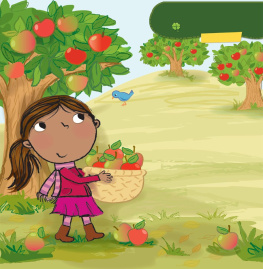Cl verleaf books
Falls Here!
Fall
Pumpkins
Orange and Plump
Martha E. H. Rustad
Illustrated by
Amanda Enright
For my cousin Andrea M. E. H. R.
Text and illustrations copyright 2012 by Lerner
PublishingGroup, Inc.
All rights reserved. International copyright secured.
No part of this book may be reproduced, stored in a
retrieval system, or transmitted in any form or by any
meanselectronic, mechanical, photocopying, recording,
or otherwisewithout the prior written permission of
Lerner Publishing Group, Inc., except for the inclusion of
brief quotations in an acknowledged review.
Millbrook Press
A division of Lerner Publishing Group, Inc.
241 First Avenue North
Minneapolis, MN 55401 U.S.A.
Website address: www.lernerbooks.com
Main body text set in Slappy Inline 18/28.
Typeface provided by T26.
Library of Congress Cataloging-in-Publication Data
Rustad, Martha E. H. (Martha Elizabeth Hillman), 1975
Fall pumpkins : orange and plump/ by Martha E. H.
Rustad ;illustrated by Amanda Enright.
p. cm. (Cloverleaf books. Falls here!)
Includes index.
ISBN 9780761350651 (lib. bdg. : alk. paper)
1. AutumnJuvenile literature.I. Enright, Amanda,
ill. II. Title.
SB347.R87 2012
635.62dc22
2010048310
Manufactured in the United States of America
1 BP 7/15/11

TABLE OF CONTENTS
Chapter One
Planting a Pumpkin Patch
It is spring, but I am thinking about fall.
Lets grow pumpkins in the garden!
We make little hills in the
soil. My hands get dirty!
We plant two or three
seeds in each hill.
Gardeners leave lots
of space between hills in a
pumpkin patch. Pumpkin
vines can grow as long as
feet (9 meters).
We dig moats around the hills.
Then we water the seeds.
Sunshine warms the wet soil.
Later, the seeds crack open. Tiny roots grow down.
Moats around pumpkin hills
help the soil stay wet. Wet
soil is good for the seeds. lt
keeps them from drying out.
Two weeks pass. Look! I see tiny seedlings.
Little leaves grow from thin vines. The vines spread out.
Curly tendrils grab on to other plants or fences.
Pumpkins need long vines to
grow. Small tendrils help the
vines spread out. Sometimes
gardeners guide the vines so
they grow in the right direction.
Chapter Two
Flowers and Pumpkins
Now it is summer. Look!
I see yellow flowers on the vines.
Male flowers have pollen inside them.
Female flowers have a bump.
Buzz! Bees spread pollen
from one flower to another.
The bump will grow to be a pumpkin.
A pumpkins female flower opens
for only one day. The flower
closes at the end of the day.
Little green pumpkins begin to grow. I water the
plants every week. They start small and grow
bigger all summer.
Leaves take in warm sunlight. Sunlight becomes
food for the growing pumpkin plant.
Pumpkins take about
one hundred days to grow.
The biggest pumpkins
can gain up to pounds
(11 kilograms) in a day.
Finally, it is fall. Harvesttime!
Cool air and short days tell the pumpkins to
stop growing. Their skin turns orange. The
leaves turn yellow. Im ready to pick one!
Most ripe pumpkins are orange, but
some kinds are green, white, blue, or
red. All pumpkins are green when they
first begin to grow.
Chapter Three
Using Pumpkins
Lets make pumpkin pie.
Splash! We wash the
pumpkins skin.
Chop! We cut
up the pumpkin and
bake the pieces.
We scoop out the soft flesh and make a pie.
It smells delicious. Yum!
Buckskin, Small Sugar,
and Winter Luxury are
types of pumpkins that
taste good in pies.
Lets carve a pumpkin. We cut open the top.
We scoop out the seeds.
Pumpkins with a lot of ridges
have a lot of seeds inside
them. Smooth pumpkins
have fewer seeds.
We cut out two eyes,
a nose, and a mouth.
Dont forget the candle.
Yikes! Our jack-o'-lantern looks spooky.
I save some of the pumpkin seeds. I will
plant them next spring. I will think about
my pumpkin patch all winter long.

































